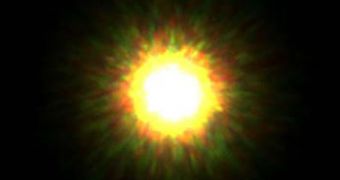Hawaii's Gemini North telescope helped capture the image of a planet orbiting a star which resembles our Sun. This is a historical event for astronomers.
Ten years ago, 1RXS J160929.1-210524 was identified by Thomas Preibisch and his team as a 5 million-year old pre-main sequence star located about 470 light years away, within the Scorpius constellation. It looks strikingly similar to our own Sun, but it seems to be a bit younger. The pre-main sequence (PMS) attribute refers to the fact that the object has not reached yet its main sequence (dwarf stars). After formation, a star generates immense energy from its dense, hot core (by fusing hydrogen atoms into helium), as its mass and chemical composition determine its position along the main sequence (or lifespan). More massive stars have shorter lives or main sequences. When all the hydrogen fuel has been consumed, the star develops away from its main sequence.
This year, Canadian astronomer David Lafreniere and two of his colleagues took pictures of the star from the Gemini Observatory, using the distortion-reducing power of its ALTAIR adaptive optics system. They discovered it was orbited at great distance by an exoplanet (extra-solar planet), which they called 1RXS J160929.1-210524 b. They labeled it a planet, although it has eight times the mass of Jupiter, but it's still under the deuterium burning limit, which would be 13 times Jupiter's mass. The researchers believe that it's improbable that it formed in situ, through the core accretion process. “This is the first time we have directly seen a planetary mass object in a likely orbit around a star like our Sun. If we confirm that this object is indeed gravitationally tied to the star, it will be a major step forward,” Lafreniere explains.
The planet is situated 330 times farther from its star than Earth is from the Sun (or about 11 times the Neptune-Sun distance). Dr. Matt Burleigh from the University of Leicester in the UK commented for BBC News, “Now the team needs to make more observations to hopefully confirm that the two are moving together through space”. This will take about two years to accomplish. The near-infrared photographies and spectra of the planet show that it it's too cool for a star or brown dwarf (1.500 degrees Celsius - 1.800 Kelvin), but rather a failed star.
The distance between the planet and the star it orbits challenges the old theories regarding the formation of stars and their planetary systems. The recent discovery is due to the survey of over 85 stars from the Upper Scorpius association, a crowd of young stars which appeared around 5 million years ago.

 14 DAY TRIAL //
14 DAY TRIAL //